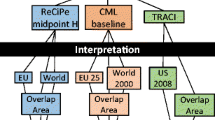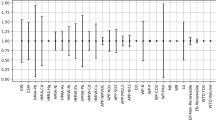Abstract
Normalization is a procedure used to convert absolute values of a system, generally expressed in different measurement scales, into normalized values, thus enabling comparison, ranking, and aggregation of attribute values. In the context of the Life Cycle Assessment (LCA), normalized results can be obtained using internal and external approaches. The latter requires normalization factors gathered within a precise spatial context (e.g., a country), and this data usually originates from environmentally aware nations. However, several countries, such as Brazil, lack this sort of data; therefore, it is more difficult to apply representative external normalization factors. Alternatively, one may apply an internal normalization approach since the analysis of the data is specific to individual assessments, thus simplifying LCA in “non-normalized” countries. Since there are many internal procedures and the literature lacks discussions on how they perform in LCA contexts, it might be challenging for decision-makers to select and apply them as Multiple Attribute Decision Making (MADM) methods. In order to fill this research gap, we performed exploratory research aiming to compare eight procedures of internal normalization through a Monte Carlo Simulation using artificial data. Results indicate that procedures of internal normalization generally present a good performance since they influence the choice of the preferable alternative in < 30% of the simulations. Additionally, only two internal normalization approaches have reduced ranking performance. On the other hand, the least influential procedures on the final ranking of alternatives were Vector Normalization and Simple Normalization using the maximum value as a reference.
Similar content being viewed by others
Data Availability
Data and material are available upon request.
Notes
Simple Normalization: 1. Using the maximum value as a reference—SNm; 2. Using the sum as a reference—SNs; 3. Using a baseline—SNb; 4. Linear Normalization—LN; 5. Vector Normalization—VN; 6. Z-Score Normalization—ZN; 7. Sigmoid Normalization—SgN; 8. Decimal Scaling Normalization—DN.
References
Hwang, C. L., & Yoon, K. (1981). Multiple attribute decision making: methods and applications—A state-of-the-art survey. Berlin: Springer-Verlag, Heidelberg. https://doi.org/10.1007/978-3-642-48318-9
ISO – International Organization for Standardization (2006). ISO 14040: Environmental management – Life Cycle Assessment—Principles and framework. Geneva: ISO copyright office. http://www.iso.org/iso/home/store/catalogue_tc/catalogue_detail.htm?csnumber=37456
ISO – International Organization for Standardization (2006). ISO 14044: Environmental management – Life cycle assessment—Requirements and guidelines. Geneva: ISO copyright office. http://www.iso.org/iso/home/store/catalogue_tc/catalogue_detail.htm?csnumber=38498
Kim, J., Yang, Y., Bae, J., & Suh, S. (2013). The importance of normalization references in interpreting Life Cycle Assessment results. Journal of Industrial Ecology. https://doi.org/10.1111/j.1530-9290.2012.00535.x
Rogers, K., & Seager, T. P. (2009). Environmental decision-making using Life Cycle Impact Assessment and stochastic Multi-Attribute Decision Analysis: A case study on alternative transportation fuels. Environmental Science & Technology. https://doi.org/10.1021/es801123h
Brent, A. C. A. (2004). Life Cycle Impact Assessment procedure with resource groups as areas of protection. International Journal of Life Cycle Assessment. https://doi.org/10.1007/BF02994191
Slapnik, M., Istenic, D., Pintar, M., & Udovc, A. (2015). Extending Life Cycle Assessment normalization factors and use of machine learning: a Slovenian case study. Ecological Indicators. https://doi.org/10.1016/j.ecolind.2014.10.028
Huijbregts, M., Steinmann, Z., Elshout, P., Stam, G., Verones, F., Vieira, M., et al. ReCiPe (2016). a harmonised life cycle impact assessment method at midpoint and endpoint level. The International Journal of Life Cycle Assessment. https://doi.org/10.1007/s11367-016-1246-y
Laurent, A., Olsen, S. I., & Hauschild, M. Z. (2011). Normalization in EDIP97 and EDIP2003: updated European inventory for 2004 and guidance towards a consistent use in practice. International Journal of Life Cycle Assessment. https://doi.org/10.1007/s11367-011-0278-6
Hauschild, M. Z., & Potting, J. (2005). Spatial differentiation in life cycle impact assessment—The EDIP2003 methodology. Environmental News no. 80. The Danish Ministry of the Environment, Environmental Protection Agency, Copenhagen.
Ji, C., & Hong, T. (2016). Comparative analysis of methods for integrating various environmental impact as a single index in life cycle assessment. Environmental Impact Assessment Review. https://doi.org/10.1016/j.eiar.2015.11.013
Inti, S., Sharma, M., & Tandon, V. (2016). An approach for performing Life Cycle Impact Assessment of pavements for evaluating alternative pavement designs. Procedia Engineering. https://doi.org/10.1016/j.proeng.2016.04.125
Tuomisto, H. L., Hodge, I. D., Riordan, P., & Macdonald, D. W. (2012). Exploring a safe operating approach to weighting in life cycle impact assessment: A case study of organic, conventional and integrated farming systems. Journal of Cleaner Production. https://doi.org/10.1016/j.jclepro.2012.06.025
Norris, G. A. (2001). The requirement of congruence in normalization. International Journal of Life Cycle Assessment. https://doi.org/10.1007/BF02977843
Seppälä, J. (2003). Life Cycle Impact Assessment based on decision analysis. Thesis – Helsinki University of Technology, Finland.
Lindeijer, E. et al. (1996). Part IV: Normalisation and valuation. In H.A. Udo De Haes et al. (Eds.), Towards a methodology for life cycle impact assessment (pp. 76–93). Brussels: SETAC – Europe.
Baumann, H., & Tillman, A.-M. (2004). The hitch hiker’s guide to LCA: an orientation in life cycle assessment—Methodology and application. Lund: Studentlitteratur AB.
Wenzel, H., Hauschild, M., & Alting, L. (1997). Environmental assessment of products: Methodology, tools and case studies in product development. Norwell: Kluwer Academic Publishers.
Pavličić, D. M. (2001). Normalization of attribute values in MADM violates the conditions of consistent choice IV, DI and α. Yugoslav Journal of Operations Research, 10(1), 109–122
Castellani, V., Sala, S., & Benini, L. (2017). Hotspots analysis and critical interpretation of food life cycle assessment studies for selecting eco-innovation options and for policy support. Journal of Cleaner Production. https://doi.org/10.1016/j.jclepro.2016.05.078
Finnveden, G., Hofstetter, P., Bare, J., Basson, L., Ciroth, A., Mettier, T. et al. (2002). Life-Cycle Impact Assessment: Striving towards best practice. Brussels: SETAC – Europe, 177–208.
Heijungs, R., Guinée, J., Kleijn, R., & Rovers, V. (2007). Bias in normalization: Causes, consequences, detection and remedies. International Journal of Life Cycle Assessment. https://doi.org/10.1065/lca2006.07.260
Brent, A. C., & Hietkamp, S. (2003). Comparative evaluation of Life Cycle Impact Assessment methods with a South African case study. International Journal of Life Cycle Assessment. https://doi.org/10.1007/BF02978746
Bare, J. C., Gloria, T., & Norris, G. A. (2006). Development of the method and U. S. normalization database for Life Cycle Impact Assessment and sustainability metrics. Environmental Science & Technology. https://doi.org/10.1021/es052494b
Jain, A., Nandakumar, K., & Ross, A. (2005). Score normalization in multimodal biometric systems. Pattern Recognition. https://doi.org/10.1016/j.patcog.2005.01.012
Loureiro, M., Bação, F. (2004). O Self-Organizing Map como ferramenta na análise geodemográfica. In: V Congresso da Geografia Portuguesa. Guimarães: Campus de Azurém. http://www.apgeo.pt/files/docs/CD_V_Congresso_APG/web/_pdf/C18_Out_Loureiro_Bacao.pdf
Rodríguez, C. K. A. (2004). Computational environment for data reprocessing in supervised classification. Dissertation – Scientific Computation, University of Puerto Rico, United States.
Sonnemann, G. W., Schuhmacher, M., & Castells, F. (2003). Uncertainty assessment by a Monte Carlo simulation in a Life Cycle Inventory of electricity produced by a waste incinerator. Journal of Cleaner Production. https://doi.org/10.1016/S0959-6526(02)00028-8
Acknowledgements
The authors would like to thank Dr. Vamilson Prudêncio da Silva Júnior for his technical support in develo** the simulation tool used in this paper.
Funding
This study was funded by the Brazilian education and research agencies “Coordination for the Improvement of Higher Education Personnel (CAPES)” and the “National Council for Scientific and Technological Development (CNPq).”
Author information
Authors and Affiliations
Corresponding author
Ethics declarations
Conflict of Interest
The authors declare no competing interests.
Additional information
Publisher's Note
Springer Nature remains neutral with regard to jurisdictional claims in published maps and institutional affiliations.
Highlights
• In LCA, the procedure of internal normalization is recommended whenever countries lack external normalization factors.
• Different internal normalization procedures are tested and compared through simulations in an exploratory study.
• Internal normalization procedures provide good performance for Multi-Criteria Analysis towards the best alternative.
• Vector Normalization and Simple (maximum value) Normalization procedures influence the ranking of alternatives the least.
Supplementary Information
Below is the link to the electronic supplementary material.
Rights and permissions
About this article
Cite this article
Sousa, S.R., Soares, S.R., Moreira, N.G. et al. Internal Normalization Procedures in the Context of LCA: A Simulation-Based Comparative Analysis. Environ Model Assess 26, 271–281 (2021). https://doi.org/10.1007/s10666-021-09767-5
Received:
Accepted:
Published:
Issue Date:
DOI: https://doi.org/10.1007/s10666-021-09767-5




